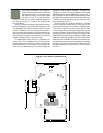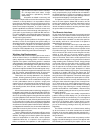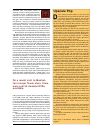
that are DD compatible. There are preamp
outs for all five channels. Build quality in gen-
eral seems up to NAD’s usual fine standards.
Also included are the NAD Link jacks, which
allow other NAD components (with NAD Link)
that are not remote controlled to be driven via the T770’s con-
troller. Very clever if one intends to stay within the NAD fam-
ily. But since the remote is not of the learning variety, the user
is penalized if he chooses to consider a competitor’s offerings.
Once I managed to hook up the Sound Dynamics RTS-3
Surround Speaker system and my Pioneer 414 DVD player,
making friends with the T770’s remote control was the next
important step. It is well organized and allows thicker fingers
some room to negotiate the keypad. And the infrared end is
angled slightly so users know how to orient the remote when
they grasp it in the dark. (A lighted keypad would have been
better.) The OSD has the requisite multiple layers. Its graphics
are concise and the critical surround set-up mode is easy to
access. The T770 circuitry will adjust the delay characteristics
of the surround system based upon the distances of the five
speakers. Then with an SPL meter (not included), it’s easy to
calibrate 5.1 speaker levels via the T770’s test tone.
For apartment dwellers, the “Late Night” feature is espe-
cially welcome for those soundtracks with lease-busting explo-
sive effects. Since it’s a compressor, it limits the dynamic range
of the audio portion. That is, the extremes of loudness will be
drawn closer together. Explosions will not be as loud, while
soft dialog will not be as quiet. This allows the user to turn the
overall volume down and still not miss important moments – a
boon for some elderly videophiles as well.
Bass management is downright basic. With a Dolby Digi-
tal source, the LFE (Low Frequency Effects) option in the
OSD’s (On Screen Display) level calibration menu permits an
attenuation of 10 dB; take it or leave it. Using this in conjunc-
tion with the Late Night feature, you can listen at reasonable
overall levels. Still, it does not have the flexibility of a THX
crossover, which allows you the option of mixing sub-80 Hz
bass information with the LFE and redirecting it to the sub-
woofer – an effective way to reduce the work load and open
up dynamics on smaller speakers.
The Sound
At 70 watts into five channels, the T770 is not a real
stump puller and speaker matching should be carefully
evaluated for sensitivity and impedance. But that said,
running the T770 as a two-channel integrated amplifier
into either the Joseph Audio RM-22 or the slightly larger
Meadowlark Shearwater loudspeakers
2
reveals a pleas-
ing, smooth sonic character. The T770 understands the
all-important midrange. It’s not aggressive in the highs
and that area in the upper mids between 2-3 kHz is full. In
my book, the midrange is the sweetspot and the NAD
really connects. Vocals, male and female, are rich and
continuous. Soundstaging is wide and fairly deep, but
imaging is not as precise as some dedicated two-channel
rigs I’ve heard. The image specificity on tracks like Roy
Gaines’ “Stormy Monday” [I’ve Got the T-Bone Wa l k e r
B l u e s ; Groove Note, GRV-2002-2] is a little swimmy. It
just doesn’t have the snappy focus that this cut can have.
Pitted against the 150wpc Plinius 8150, my reference inte-
grated amplifier, the T770 sounds slightly dry. Bass is not
quite as rich and extended. But neither is it muddy or ill-
defined. It’s just a little rolled off.
The heart of the T770 is its competence in decoding Dolby
Digital soundtracks. Intelligibility of dialog is paramount not
only to understanding but to conveying nuance and atmos-
phere. One of the easiest ways to test for this is to find sound-
tracks where narration occurs. The Tennessee Mountain nar-
ration of actor Jeff Jeffcoat in the charming and overlooked
film The Education of Little Tree [Richard Friedenberg, direc-
tor; Paramount Home Video LV336143] is a prime example of
how a few well-chosen words can whisk the movie-goer into
a different time and place. The warm, non-aggressive
midrange character of this voice sounded remarkably similar
to the theatrical presentation I attended at the state of the art
Academy Theater in Los Angeles. And when you listen to the
West Virginia drawl of Levon Helm from The Right Stuff
[Philip Kaufman, director; Warner Bros. 20027] through the
T770, you not only catch every inflection with clarity and
smoothness, you can almost smell that stick of Beemans gum
he just started chewing.
The sound design of the film Elizabeth gave the NAD’s
decoder a thorough workout in retrieving ambience via – of
all things – footsteps! The movie’s interiors are set primarily
in medieval castles and churches. These large vaulted expans-
es have huge reverberant fields with delay characteristics bor-
dering on echo chamber. Throughout the movie, characters
are shown in medium and long shots walking through these
cavernous spaces, sometimes from above, other times at eye
level. The NAD demonstrated exemplary steering combined
with fast transient attack by not only localizing approaching
and departing footfalls from LCRs into the surrounds then
back again, but by taking those footfalls and their accompa-
nying reverberations and shifting them spatially to another
combination of speakers as the camera set-up shifted. Each
camera position yields a similar but distinctive spatial per-
spective. A thunderstorm sequence during chapter eight
reveals the T770’s ability to place powerful cues deep in the
background, an auditory illusion that appeared to be occur-
ring well behind the LCR speakers.
For spatial resolution I use the “Raindrops Keep Falling
on my Head” Test. In this case directly overhead. The DVD of
Das Boot, The Director’s Cut [Wolfgang Peterson, director;
Columbia-Tristar 22219] has some of the finest, most immer-
sive sound effects I’ve experienced in a movie soundtrack –
the metallic clatter of the diesel engines in the background,
the occasional groan of the boat’s hull as it descends deeper
than it was ever engineered to go. The sound designers
implanted a living, breathing soul within the vessel and her
fate is very nearly as poignant as that of the submariners she
carries. You can close your eyes and almost smell the mildew
hanging in the stale air. And feel the panic as claustrophobia
takes hold. The “Raindrops” test occurs late in the film, with
the U-boat crippled on the sea floor near the Straits of Gibral-
tar. Pipes have burst from the pressure on the bulkheads and
the sounds of discrete leaks are plopping in all channels.
These sounds were clean and startlingly lifelike. But there is
one specific leak that consistently dropped right down my
back, courtesy of the NAD T770 system. And it appeared to be
coming from my ceiling! This immediacy was not accom-
1 NAD points out that EARS is left-minus-right channel ambient process-
ing, incorporating no reverb.
2 86 dB & 88 dB sensitive respectively.


















